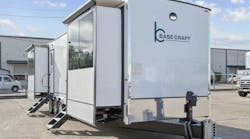A Slower Fourth Quarter, But Positive Expectations for 2025, Baird/RER Survey Respondents Say
Revenue for the fourth quarter of 2024 revenue-weighted increased 1.1 percent year over year, according to respondents to the quarter Baird/RER rental equipment industry survey, the slowest growth post-pandemic. In the third quarter, revenue rose 1.7 percent year over year. Thirty-four percent of survey respondents reported that fourth quarter missed internal budgets, while 13 percent said they posted better-than-expected results. Fifty-two percent of respondents said revenue was in line with expectations. The net negative (-21 percent) is the fifth straight quarter below expectations.
Baird’s interpretation is that a demand slowdown is increasingly visible with growth below pre-pandemic levels.
There are multiple factors dragging performance: the lagged effect of higher rates on “local” construction and some project pushouts. At the same time, fleets have grown, with overfleeting becoming a problem.
“Slowing nonresidential construction accompanied by minimal megaprojects,” said one comment. “’Local’ commercial construction likely will not accelerate until the second half of 2025 at best.”
“Contractors report lots of work but waiting for funding to be released,” said another.
“The market has supply for anyone that would normally buy; there is less rental,” opined a third.
Fleet utilization for the fourth quarter was 62.4 percent, compared to 63.4 percent in the third quarter of 2024, and 62 percent in the fourth quarter of 2023. Supply of equipment has increased while demand growth is moderate.
The utilization rate fo access equipment decreased to 66.2 percent from 67 percent in Q423. Utilization for earthmoving equipment increased to 63.7 percent from 63.4 percent in Q223.
One respondent noted a “focus on price versus availability with lower utilization rates.”
“Definitely a slow end of 2024,” said another. “Competition is getting more aggressive as everyone competed for a smaller piece of pie. Excited for 2025 and hopefully an upswing in business.”
“Cost of fleet and pressure on rates from the majors as they try to hold time utilization,” said another.
“People seem concerned about the economy and are delaying or scaling back projects,” added another.
Rental rates are still slightly positive, with modest growth still expected in 2025. Average rental rate was up 0.4 percent year over year, a modest improvement from last quarter, and down from -1 percent growth the previous three quarters and peak of 5 percent in the fourth quarter of 2022. Respondents are expecting 1.8 percent rental rate growth in 2025, which reflects a slightly more optimistic attitude than the previous quarter.
“Competition and inventories are high, leading to a race to the bottom for rates,” said one respondent. “We are expecting improvements in 2025.”
“We are expecting things to start slow but end well in our area,” said another. “Rates will decline because the market is saturated.”
“The rental market remains dramatically oversupplied,” added another. “More equipment is sitting in competitors’ yards than has been witnessed in almost a decade. One national competitor has closed operations and left the market. Equipment utilization is at a 13-year low in the region as stated by one of the national analytical firms.”
Fleet spending remains subdued. Respondents expect a 3-percent increase in spending over the next six months. Looking to 2025 as a whole, respondents expect flattish fleet spending growth, with some factoring in effects from lower rates later in 2025.
Replacement demand is likely not a significant factor driving capex. Forty-seven perdent of revenue-weighted respondents reported a younger fleet compared to two to three years ago, with 33 percent reporting an older fleet. Fleet ages have adjusted as new equipment lead times normalized in 2024.
Which markets look good?
Infrastructure and Nonresidential end markets have the most positive outlooks for 2025, driven by sizable government stimulus funding and (potentially) lower financing rates. Residential construction is showing a negative reversal in expectations, likely caused by stubbornly high mortgage rates. Less favorable end markets include Municipal/Government (68 percent compared to 82 percent last year), Oil & Gas (55 percent compared to 72 percent last year), along with Residential (28 percent vs. 52 percent last year.)
For the first quarter of 2025, respondents are expecting about a 5 percent year-over-year growth, representing improvement versus recent deceleration. For the full year, average rental revenue is expected to be up 7.3 percent in 2025, whereas last quarter respondents expected a 3.1-percent growth in 2025. This estimate is higher than actual growth in the fourth quarter and above the first quarter forecast of 5.4-percent improvement. Many respondents pointed to the outcome of the recent presidential election as a key driver of improved expectations.
“2025 should be a very good year based on what our customers are telling us,” said one respondent.
“Expecting a very strong second half of 2025,” said another. “Rates will likely climb as demand outpaces supply.”
“Positive attitude after the election,” said a third.








